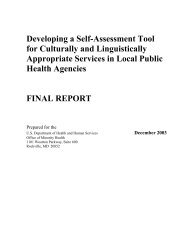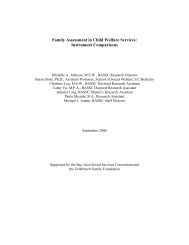Barbara Needell, Principal Investigator Stephanie Cuccaro-Alamin ...
Barbara Needell, Principal Investigator Stephanie Cuccaro-Alamin ...
Barbara Needell, Principal Investigator Stephanie Cuccaro-Alamin ...
- No tags were found...
You also want an ePaper? Increase the reach of your titles
YUMPU automatically turns print PDFs into web optimized ePapers that Google loves.
3It has been estimated that nearly 20,000 U.S. children emancipate from foster care eachyear (USDHHS, 1999). Previous research has indicated that these youth often face seriouschallenges as they enter the adult world. In December, 1999, then President Clinton signed intolaw the Foster Care Independence Act of 1999, (P.L. 106-109), which includes provisions toassist youth leaving foster care by offering better educational opportunities, access to health care,training, housing assistance, and other services (USDHHS, 1999).Foster care data had previously been reconfigured into longitudinal format at the Centerfor Social Services Research (CSSR) as part of the California Children’s Services Archive. 1Available social security numbers (SSNs) for emancipating youth were provided to seven stateagencies who may have served these youth, data were linked by the agencies, and linked datawere then provided to CSSR staff. Linkage to each of these administrative datasets is anindicator of an outcome. For example, emancipating youth whose records were linked to thestate prison database were considered to have entered prison; those for whom there was nolinkage were considered not to have entered prison. For some data, (MEDS, Mental Health,Vital Statistics), individual level data with identifiers were provided, allowing for analysis at thechild specific level. Individual level data were also provided regarding Community Collegeenrollment, but without identifiers and with some data suppressed due to small sample sizes.California Youth Authority data was also provided without identifiers. State prison and GEDdata were provided in the aggregate. All analyses were run separately for emancipating childwelfare (ECW) and emancipating probation (EPR) youth. In many cases, the sample of femaleEPR youth was too small for meaningful interpretation.Most of the existing research on emancipation from foster care uses interviews withformer foster youth. Only recently have administrative data been used as a tool to inform thisissue. The study reported here uses a sample of 12,306 youth who emancipated 2 from foster carein California between the years of 1992 and 1997.In summary:1. A substantial number of California youth are growing up in child welfaresupervised foster care, and many of these youth are having multiple placementswhile in care.2. Most youth in foster care receive some kind of mental health services. The mostcommon diagnosis for youth emancipating from the child welfare system was amood disorder, while the most common diagnosis for youth emancipating fromthe probation system was a behavior disorder. Youth placed with kin are lesslikely to receive mental health services than those in other placement types, andyouth in group homes are by far the most likely to receive mental health services.1 Data was derived from the Foster Care Information system (FCIS) database, supplied to CSSR through aninteragency agreement with the California Department of Social Services.2 Children who exited the foster care system with a reason for termination code of “Emancipation or Age ofMajority”, or who exited at age 19 or older with no termination reason given.
















